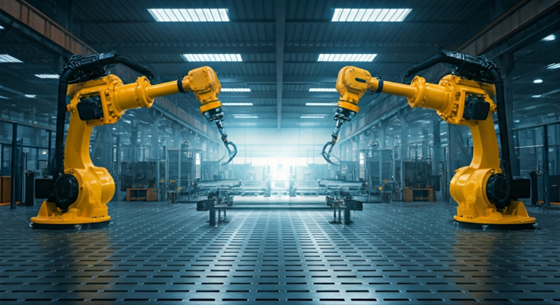Discover the Benefits of Automatic Manufacturing System

Discover the Benefits of Automatic Manufacturing System
Key Highlights
- Smart manufacturing brings in advanced automated systems. These help to make work in manufacturing plants better and faster. They also boost overall efficiency in the way things are made.
- Automation helps to cut down the risk of human error. It raises product quality, keeps things steady, and makes sure the work stays on track and precise in every step of the production lines.
- Using programmable and flexible automation lets you do batch production. You can also make changes in real time. This makes it easy to change with the market and do what people want.
- To set up advanced manufacturing systems, you need key resources like CNC machines and smart software systems. These tools help you have good manufacturing systems in place.
- The first costs of buying and setting up are high. But with good budgeting and inventory management, you save over the years.
- If you want automation to work well, you need to look at what you have, plan ahead, pick the right tools, and train your team. This will help you fit automation into your work smoothly.
Introduction
Smart manufacturing is changing the way we do things in the manufacturing industry. With the help of
automation systems, AI, and robotics, manufacturing systems can now get more work done with less effort. They handle repetitive tasks on the production floor, so people do not have to do the same thing over and over. This helps to cut down on human errors. When these new tools are in use, businesses can lower operating costs, increase how much they can make, and improve product quality. The use of automation is making a big difference on the production line. If you want your business to do well in the long run, it is important to understand what automation brings to the table and how it can make your production better.
Exploring the Future of Automatic Manufacturing Today
What is Smart Manufacturing?
Smart manufacturing uses new automation systems to make things work better, lower costs, and help the production line make more goods. It uses AI, robotics, and the Internet of Things to bring together old ways of making things with new, data-driven plans.
This new way removes problems and helps manufacturers meet changing customer needs. Automated systems work all along the production line. These systems lead to better precision, less waste, and a safer place to work. Let’s look at the basics and learn how automation is a big part of this change.
Definition and core principles
At its core, smart manufacturing means using programmable automation and flexible systems to help make production better. Programmable automation lets businesses do batch production that can change with different product needs. This flexibility helps companies change their production lines when the market changes.
Some key ideas in smart manufacturing are lowering downtime, improving safety at work, and making sure the products are always good quality. Flexible automation systems help make fast changes in how things are produced, without long delays. These systems also connect easily with main control systems, so people can watch and control things from far away.
By using smart manufacturing, businesses build connected groups of control systems, industrial robots, and advanced machinery. This brings together technology with what people know best, balancing automated speed with smart choices. Smart manufacturing is not only about getting new technology. It is a way for the manufacturing industry to support growth and sustainability for the future, using things like automation, automation systems, and the right mix of machines and people, while keeping downtime low.
The role of automation in smart manufacturing
Automation is at the heart of smart manufacturing. It changes the manufacturing process by making things work with industrial robots, control systems, and automated systems. Using automation helps companies lower the risk of mistakes that people might make. It lets factories create the same quality products again and again with more trust.
When businesses use automated systems, they can keep working all day and night with little or no downtime. This setup increases how much they can get done and helps with batch production, too. Tasks like quality control become easier, and products will have fewer problems, because the robotics used make sure everything meets certain standards. Automation means the work on the factory floor is more smooth and works better.
Automation is also good for keeping human workers safe, as they do not have to do dangerous jobs in the manufacturing process. If companies use programmable automation, they can make batch production easier, lower waste, and make the production line more steady. This helps meet what people want in the market. So, automation is changing how industries use the factory floor, raising profits and making both companies and customers more happy.
Essential Equipment and Resources for Starting in Smart Manufacturing
Transitioning to smart manufacturing means you have to put money into the right tools and systems. This helps to bring new life to the way things are made. You use cnc machines that have computer numerical control. These come with programmable automation to help you get precision in making products.
You also need to use software for inventory management and control systems. They give you real-time data. This helps you make better choices and spot ways to be more efficient. The first costs of smart manufacturing can be high. But making these changes will change how you work, and give you the boost you need for long-term success on the production floor.
Types of machines and software needed
Smart manufacturing needs certain things to work well. The main resources for this are advanced CNC machines, robotics, and special software. CNC machines, which use computer numerical control, let the people in a factory use computers to run detailed production work. This means the machines can carry out complex jobs fast and with great accuracy.
Automation systems work together with smart software. This includes inventory management tools. When used together, these automation systems and software help get data on how the work is going. They show where the work in the factory is not running smoothly. So, people find out ways to make things better without needing to hire more workers.
PLCs, which are programmable logic controllers, also play a big role in the manufacturing automation world. These small computers talk to machinery by using a sort of coded talk. That way, they keep jobs in the factory going steady and can handle different workflows as needed. There is a whole group of helpful technologies here, from CAD design software to robotic automation systems. They all come together to give manufacturers a fast, steady, and high-quality way to make things through quality control and automation. These tools let manufacturers grow quickly and run strong manufacturing automation systems.
Initial setup costs and budgeting tips
Adopting smart manufacturing means the business will have a high initial investment to pay for things like new machinery, software, and training the workforce. Still, smart budgeting helps cut down these costs. Businesses need to choose automation systems that help them meet production goals. Good inventory management also helps reduce waste.
A cost assessment that looks at all the details will help balance the big expenses at the start with the benefits the business will get later. For example, spending money on flexible automation lets the business scale up as needed. It also keeps the cost of making changes later much lower. Here is a text table that shows where the money goes at first:
| Expense Categories | Details |
|---|---|
| Infrastructure Upgrade | Factory upgrades, installation of equipment |
| Automation Hardware | CNC machines, industrial robots |
| Software Systems | Inventory management, control systems |
| Training Workforce | Employee automation training programs |
| Maintenance Costs | Machinery servicing and spare parts |
Careful money management will make sure companies get a good return from their investment as they scale up and work more efficiently.
Step-by-Step Guide to Implementing Automation in Smart Manufacturing
Deploying automation in your manufacturing systems needs a clear step-by-step plan. First, look at the current process to find areas where things slow down or do not work well.
After this, pick the automation systems that work best for you. Think about your batch production needs and if any machinery has to be upgraded. Then, train employees well while you bring these new tools into your systems. These steps can help you build a better production line. You will get stronger quality control and improve the overall efficiency of your manufacturing plants with the right automation.
Step 1: Assessing your current manufacturing processes
Start by looking closely at your production process. Find out where things slow down. You may see problems with repetitive tasks, too much downtime, or failures in quality control. For example, look at the risk of human error in what you do now. Work out which areas need to get better right away.
Quality control numbers, reports on production delays, and machines that report their health can give you good ideas about what needs to be fixed in the production line. When you know what is slowing down your manufacturing systems, you can start to build a plan for automation.
Also, talk with factory floor supervisors. Ask them what bottlenecks they see. Their thoughts will show you where automation could make complex tasks easier and raise productivity. When you carefully check every area of your operations, you get ready to set clear goals for using automation systems that will help you work better and faster.
Step 2: Identifying areas for automation
Finding out where automation will work best is important to get the most out of manufacturing plants. Start by looking at jobs that are done the same way over and over, like batch production. These jobs can be good places to add automated systems. You should look for tasks that may stop easily or be slowed down by human error. These should get more attention in your automation plans.
There are different types of automation you can use. Fixed automation is best when you are making a lot of the same thing. Flexible automation works better if you want to change what you make from time to time or run different steps. Looking at the key benefits of each way helps make sure you choose what fits your goals.
You also need to look at areas that need to react to changes in the market. For example, in the beverage industry, companies use automation to help products move faster. IoT sensors check batch quantities and show how production steps change. Focusing on processes that can get a lot better when you use automation will help a business get the most out of what they invest and keep up with changes in demand.
Step 3: Choosing the right automation tools
Choosing the right machine tools is a key step when you want to bring in automation to the factory floor. Using tools with computer numerical control systems lets people run their work by programs, so every step can be done fast and well.
Today, modern assembly device(s) connect with the internet of things. This gives companies up-to-date production information. With this, you can spot downtime, look at what does not work right, and change how things run without slowing down the whole process. The flexibility in modern automation systems also means these can grow as your business grows.
When you use factory floor machinery that works with the industrial internet of things, you get smart features. These let people keep an eye on work from a distance. If you go with machine tools that bring in things like CAD-designed machinery or networks that use wireless control, you help your team get steady, high precision and be ready for anything along the production line.
Step 4: Training staff and integrating systems
Employee training is very important when a company moves to automation. Human workers need help to learn the basics of programming. This training will let them use new control systems in the right way. Be sure to set up step-by-step lessons. These sessions break down complex tasks, so people can use IoT platforms and automated machinery without stress.
Systems integration brings together old and new ways of making things. If the company uses robotics or machine tools, good integration helps keep work moving with high productivity during this time of change.
Encourage the automation team and other employees to work with each other. When people ask questions, there should be fast answers. This kind of teamwork makes it easier for everyone to adapt. It also gives human workers more confidence while they get to know the new systems. For automation to do well in the long run, the staff and systems in the production line must work together smoothly. Give people the materials and support they need to bring together automation and human skills. This will lead to the best outcome for all.
Conclusion
To sum up, moving toward smart manufacturing is more than just a new idea. It is an important way to make things work better in the manufacturing world. By making use of automation and the right technology, you can make your work easier, save money, and make your product quality better. The path to smart manufacturing might look hard at first. But if you have a plan and the right help, you can reach your goal. If you want to change how you make things and use the power of automation, talk to our team. We offer a free consultation and can show you what we can do for you on this journey.
Frequently Asked Questions
What is the initial cost of setting up a smart manufacturing unit?
The starting cost for automation depends on a few things. It will be shaped by the size of the automation you want, the type of machinery you need, and if any upgrades are needed in the building. Most of the time, you need a high initial investment. This covers things like industrial robots, automation systems, and inventory management software. To use money in the best way at manufacturing plants, you need to plan your budget. This helps make sure there is enough for both batch quantities and any growth that could happen in the future.
How does automation impact product quality in smart manufacturing?
Automation helps improve product quality in the manufacturing process because it reduces human mistakes. Automated systems add more precision and bring the same results every time. This focus on quality control means each product looks and works the same. With this consistency, businesses keep their customers happy and grow their good name by offering reliable, defect-free products.




